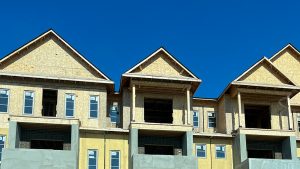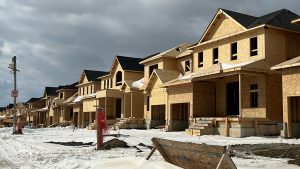Policymakers and homebuilders should make the measurement of material carbon emissions (MCE) in materials used to construct homes a regular part of the design and permitting process, states a new study.
The study, which documented greenhouse gas (GHG) emissions from building materials used to construct low-rise homes in the Greater Toronto and Hamilton Area (GTHA), found they contribute about 840,000 tonnes of carbon dioxide each year, equivalent to the emissions from more than 183,000 automobiles.
Many homebuilding materials were not included in the study, such as mechanical, electrical and plumbing, appliances, millwork, paints and driveways mostly due to lack of emissions data, so more realistically, low-rise homes are believed to be contributing 1.5 to 1.75 million tonnes of emissions each year.
Chris Magwood, lead researcher for the study, says measurement of MCE emissions should become standard practice when building new homes in order to collect more accurate and complete data which can be used to help to drive voluntary emission reductions and inform future regulatory interventions.
“You can’t fix what you don’t measure. Simply having everyone begin to do the measurements is the most important first step,” explained the consultant. “We’ve found that many builders will adjust their practices without any regulation once they see where the low-hanging fruit exists in their designs.”
The study, Emissions of Materials Benchmark Assessment for Residential Construction, was done by Passive Buildings Canada and Builders for Climate Action with funds from The Atmospheric Fund. It’s the first study that documents GHG emissions from building materials used to construct homes in the GTHA.
Researchers examined data from more than 500 single-detached, semi-detached and townhouses in the GTHA built between 2017 and 2020. The purpose of the research is to provide decision-makers, such as developers and builders, with insights about choices they can make to reduce GHG emissions in new builds. The study identifies specific materials and construction assemblies within buildings that are responsible for the most emissions and identifies opportunities for significant reductions by comparing options for each material.
The results will enable GTHA regulators to assess how different policy options might lead to large-scale material emission reductions to complement existing GHG reduction goals in the building sector.
Researchers solicited plan sets from GTHA builders and asked how many times each plan set had been built over the three-year window of the study. They studied 59 plans that represented 503 as-built homes in the region.
“This is the first time that a large sample of as-built homes have been studied using the same methodology,” said Magwood. “So it’s the first time that such a study is giving an accurate and comparable picture of the issue in a particular region.”
The study was done because earlier research pointed to the fact that MCE from building materials was much higher than anybody had really considered.
It showed if best available materials were used for future low-rise homes it would result in 573,000 tonnes fewer emissions annually in the GTHA, a 68-per-cent reduction
“If we took sample plans from the study and made substitutions for six materials that are cost-comparable, code-compliant and widely available in the market, we could see reductions that ranged from 50 to 75 per cent on the sample home plans when we made these substitutions,” explained Magwood.
Researchers are hoping builders make better choices that will reduce GHG emissions. They are recommending municipalities focus on establishing metrics for entire projects and avoid regulations that focus on specific high-emitting materials.
They also suggest home designs be examined early on to ensure that materials that store carbon are being used and builders set targets that are achievable within a two-to-five-year window.
“We discourage regulations that focus on particular materials and encourage regulators to think about whole-building results,” said Magwood. “It is possible to build a home with some high-emitting materials that has overall lower emissions.”
He said researchers feel it is best to allow builders to have as much flexibility as possible to meet any targets.
Most cities that have started to initiate regulations on embodied carbon have begun by simply requiring the measurement of these emissions at the permit stage, said Magwood. This gets builders used to doing the calculations and gives cities a good data set to start setting incentives and regulations.
The study has been shared with policymakers, builders, developers and material manufacturers across the region.
A series of free online learning sessions has been scheduled and researchers are working one-on-one with people from all the groups.
Toronto Green Standard V4 is including embodied carbon caps for its voluntary levels 2 and 3 based on the results of the study. Those caps will eventually become mandatory and the researchers are hoping other municipalities in the GTHA will incorporate similar plans moving forward.
Leading homebuilders have reacted very positively to the study and have started to shift practices of their own accord, said Magwood.
“This is really encouraging and we hope their early moves have positive impacts across the industry.”











Recent Comments